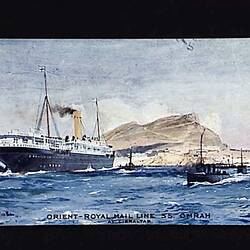Summary
Cream-coloured World War I Australian Repatriation Fund fund-raising ribbon, featuring an image of King George V in red and blue. It is dated 4 June 1917.
The ribbon is likely to have been used in Queensland. The King's Birthday, celebrated on 4 June 1917, became the focus for a range of fund-raising activities in Queensland (at least) in support of the war effort. In Toowoomba, 3000 school children formed a procession, each carrying the flag of an allied nation. They were joined by 40 returned soldiers, the mayor and the Salvation Army Band. About £1000 was expected to be raised (Brisbane Courier, 5 June 1917, p.8). The king's image on the ribbon appeared in the Brisbane Courier, 4 June 1917, p.2, next to the heading 'MONSTER CARNIVAL, EXHIBITION GROUNDS'. In contrast, the Argus reported that Melburnians would be treated to a Victoria Racing Club Birthday Meeting at Flemington on that day (4 June, p.6), with no mention of fund-raising. Two days later the Argus reported on planning for a special race day at Moonee Valley in the future that would support repatriation (6 June, p.6).
Physical Description
Cream-coloured ribbon, printed in blue and red. The ribbon features an image of King George V (head and shoulders), with a flag on either wise, with inscriptions above and below. Selvage on sides of ribbon; both ends are cut, suggesting the ribbon was taken from a role of the same.
Significance
During World War I, large numbers of benevolent societies and privately-run patriotic funds and charities were formed to raise money for Australia's soldiers. Fundraising efforts included badges and ribbons for sale, raffles, lotteries, and special events such as 'Win the War Day' and 'Allies Day'. Money, food, vehicles and whole buildings were donated. These activities raised large amounts of money, estimated at in 1921 as being at least £12,121,872. The money provided troops with warm clothing and comforts packages. It also provided care and rehabilitation of returned soldiers, and funds for civilian wartime victims in Allied Europe, and later the erection of memorials and the care of war graves in Australia. Importantly, the efforts bolstered community support for, and engagement with, the war effort, and elevated morale during a socially-challenging time.
More Information
-
Collecting Areas
-
Acquisition Information
Purchase
-
Place & Date Used
Queensland, Australia, 4 Jun 1917
Possible place used. -
Person Depicted
-
Inscriptions
Printed on ribbon: 'AUSTRALIAN / REPATRIATION / FUND. / TO HONOUR THE KING / AND HELP OUR / HEROES / JUNE 4, 1917.'
-
Classification
-
Category
-
Discipline
-
Type of item
-
Overall Dimensions
34 mm (Width), 75 mm (Height)
-
References
Information on fundraising from Australian War Memorial, [Link 1]
-
Keywords
Defence Forces, World War I Fundraising, World War I, 1914-1918


